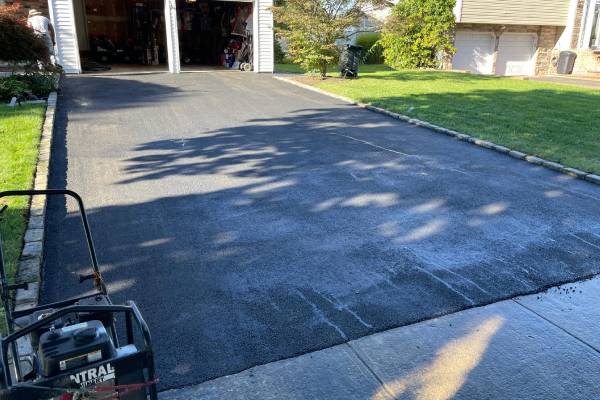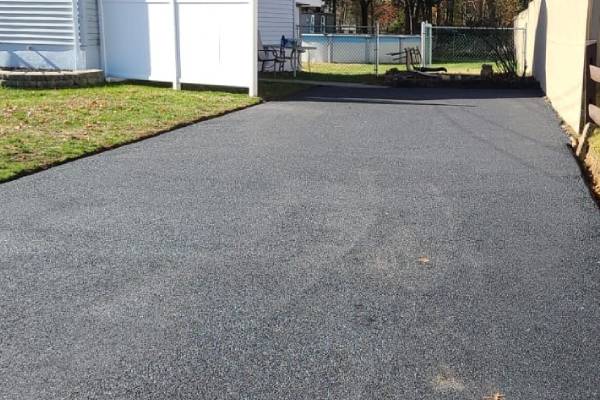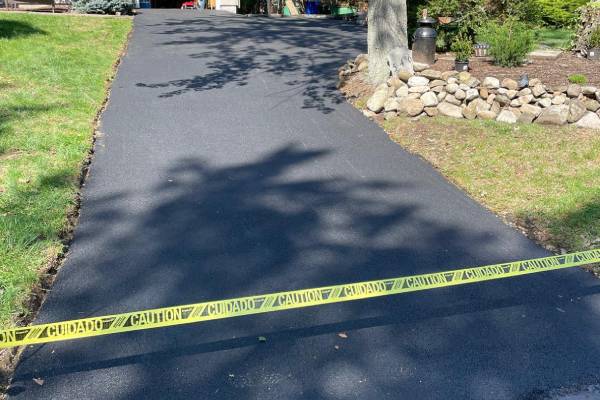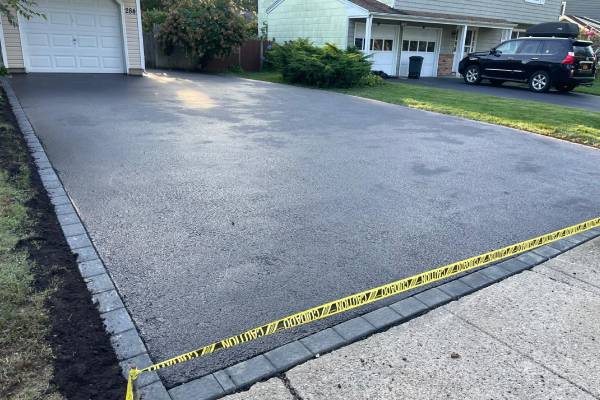A snow-covered driveway on Long Island. Early winter maintenance can prevent icy hazards. Winter on Long Island often brings freezing rain and snowstorms that can turn driveways and walkways into dangerous, slippery surfaces. In fact, ice-related slips and falls cause thousands of injuries and billions in medical costs each year.
The Town of Huntington even urges residents to keep front walkways clear for emergency access. Islandwide Paving & Masonry, your local paving contractors, knows that proper winter preparation is key. Our asphalt and concrete driveway contractors recommend proactive maintenance to keep your property safe and ice-free.
Why is Ice Build-Up Dangerous for Driveways and Pathways?

Ice accumulation on driveways and sidewalks poses serious hazards. Slipping on ice can lead to broken bones, head injuries, or costly lawsuits. National data shows that snow and ice contribute to over 20% of workplace slips and falls, and the CDC estimates over 800,000 Americans were hospitalized from slip-and-fall injuries due to ice, with more than $50 billion in medical costs. In parking lots and pathways, nearly a quarter of winter falls occur and often require time off work. Beyond personal injury, ice can damage pavement: water seeps into cracks, freezes, and expands, worsening potholes and erosion. For both homeowners and businesses on Long Island, preventing icy buildup is essential to avoid accidents and expensive repairs. Our residential asphalt paving contractors and commercial paving contractors emphasize that an ounce of prevention is worth a pound of cure for ice hazards.
Long-Term Winter Maintenance Tips for Safer Pathways

Preparing your driveway for winter before the first storm can make all the difference. In the fall, inspect your pavement for cracks or low spots and have them repaired. Keep gutters and drainage systems clear so that melting snow can flow away from your driveway. Make sure your driveway is pitched to direct water off to the side and not pond on the surface. Trim any overhanging branches or vegetation that might drop snow or ice onto walkways. For asphalt driveways, it’s wise to apply a fresh sealant every few years; sealcoating prevents water from seeping into the pavement and reduces freeze-thaw damage. Likewise, concrete driveways should be sealed and patched to close gaps where water can enter and turn to ice. Regular sealcoating done by professional paving contractors protects the surface and helps prevent ice buildup.
Islandwide Paving & Masonry (your local asphalt driveway contractors) recommends establishing a winter routine: keep a high-quality shovel or snow blower on hand, stock pet-safe ice melt, and consider installing snow fences or borders to guide drifting snow away from critical areas. We’ve long-term experience in Long Island winters and know that these proactive steps are much easier (and cheaper) than dealing with hardened ice and surface damage later.
Prevention vs. Removal: Which is More Effective?
When it comes to ice control, prevention is far more efficient than constantly trying to remove ice after it forms. For example, many municipalities use a technique called anti-icing pre-treating pavement with a brine solution before a storm because it achieves the same ice-control level with only a fraction of the salt needed by reactive deicing. In fact, studies show pre-treatment (spraying brine in advance) can use only 20–25% as much salt compared to waiting until snow and ice bond to the pavement.
For homeowners, this means applying a liquid de-icer or salt mix just before a storm can greatly reduce ice formation. This is more effective and environmentally friendly than scattering salt on thick ice later. Regular removal is still important shoveling or plowing snow promptly prevents thick ice layers from forming but combining it with preventative measures (like pre-salting and good drainage) yields the best results. Islandwide’s commercial paving contractors often advise clients to schedule a pre-storm treatment if a major storm is forecasted. By contrast, waiting to remove ice can mean more effort (and more damaging freeze-thaw cycles for the pavement) later on.
Heated Driveways and Pathways: Are They Worth the Investment?

Heated driveways and walkways are an innovative long-term solution to winter ice. By embedding electric heating cables or hot-water tubes beneath the pavement, these systems melt snow on contact. The benefits are clear: no shoveling or manual deicing, uninterrupted access, and significantly reduced slip risks. Heated systems are especially appealing on critical paths (walkways to front doors, steps, or steep driveways) where safety is paramount. A long-term analysis shows that in consistently snowy climates, heated driveways can even add value to your home as a convenience feature.
However, the upfront cost is high. Current data indicates a heated driveway system averages about $12,000–$15,000 to install (factors include square footage, driveway material, and system type). For example, heating an asphalt driveway typically runs $12–$25 per square foot. If you’re sick of back-breaking shoveling or paying for snow removal services, a heated system may pay off over many winters. One review notes that heated driveways “eliminate the need for manual shoveling, which means you avoid potential injuries” and “avoid recurring expenses associated with hiring a snow removal service”.
Islandwide Paving & Masonry can install these systems under new or existing concrete or asphalt driveways. For example, one case study notes that heating systems can be customized (you might only heat two 24-inch tire tracks, for instance) to match your budget and needs. Before deciding, consider your Long Island home’s snowfall patterns and budget. Even if you opt out of full heating, combining moderate treatments (like heated tire tracks) with traditional plowing often yields a good balance of convenience and cost. Contact us to evaluate if a heated pavement system is right for your property, or to get a quote on installation.
Eco-Friendly and Pet-Safe Ice Prevention Options
Traditional rock salt (sodium chloride) is inexpensive, but it carries downsides: it corrodes concrete and metal, harms nearby landscaping, and even endangers pets and wildlife. As one pet safety guide warns, common deicers like NaCl and CaCl₂ can cause burns on paws or worse if ingested. Long Island pet owners should consider pet-safe ice melts. These are often based on magnesium chloride or calcium magnesium acetate, which are far less harmful. For instance, calcium magnesium acetate (CMA) is recommended for concrete since it prevents freezing without corroding surfaces.
From an environmental perspective, the EPA notes that sodium chloride runoff can contaminate water supplies and kill vegetation. Magnesium chloride is safer than rock salt but needs more product, while calcium chloride is more benign but costly. Some municipalities even add biodegradable additives (like beet juice or molasses) to salt brine to reduce the total amount of salt needed. For home use, products labeled pet-safe or plant-friendly are a good choice. They often rely on substances like magnesium chloride or safer organic compounds.
Islandwide Paving’s concrete driveway contractors advise using these gentler alternatives. For light frost, a thin layer of sand or kitty litter can add traction without chemicals. Heated mats or liquid anti-icers (sprayed before a storm) can also minimize the need for deicing agents. Always wipe off pet paws when coming indoors. By choosing eco-friendly ice-melts and using them sparingly, you keep pathways clear and protect your family and landscaping.
The Role of Driveway Sealants in Ice Prevention
A well-maintained driveway repels water and slows ice formation. Applying a quality sealant to asphalt or concrete fills micro-cracks and creates a hydrophobic barrier. This means melting snow is less likely to seep in and refreeze underneath. As one home maintenance guide notes, “Regularly seal your driveway to prevent water from seeping into cracks… and apply a sealant every few years to protect the surface”. In asphalt driveways, sealing not only restores the surface but also guards against deep freeze-thaw damage.
Our residential concrete driveway contractors also caution that salt and water will eat away at pavement edges if not protected. We recommend a sealcoating schedule: typically every 2–3 years for asphalt, and concrete sealing if you live in areas with heavy winter use. Beyond sealants, prompt repairs are key: address any potholes or vertical cracks in fall so water can’t pool and freeze. These steps, combined with gentle deicers, ensure that pavement itself doesn’t become an ice hazard. Islandwide Paving & Masonry offers professional sealcoating services on Long Island – contact us to schedule a driveway evaluation before winter arrives.
Ways to Prevent Ice Build-Up on Your Driveway and Pathways
Islandwide Paving & Masonry recommends these practical steps to keep your property safe all winter.

Regular Snow Removal
Shovel or plow snow as soon as it accumulates. Clearing light snow early prevents it from compacting into hard ice. For added traction on snow-free surfaces, spread a thin layer of sand or grit.
Proper Drainage
Ensure water doesn’t pool by grading your driveway away from traffic areas. Keep gutters, downspouts, and driveway channels clear so melting snow drains off the pavement, not across it.
Consider Heated Driveways
If shoveling is impractical, a heated system can melt snow automatically. This is an especially good option for steep or long driveways. Heated concrete or asphalt systems (installed by our contractors) turn winter maintenance into a push-button task.
Seal Your Pavement
Apply or refresh sealant coatings before winter. A sealed driveway repels water, reducing freeze-thaw damage. Cracks and potholes should be repaired promptly so they don’t fill with ice.
Regular Maintenance Checks
Throughout winter, inspect your pavement. Fill any developing potholes, straighten shifted pavers, and reapply sand or pet-safe ice melt to high-traffic areas. Preventive upkeep now avoids bigger headaches (and repair bills) in spring.
By combining these practices, you substantially cut down on ice formation and the need for harsh chemicals or laborious snow removal.
Conclusion
Preventing ice build-up on your Long Island driveway and pathways is all about proactive care. Small investments in drainage, sealcoating, and pet-safe deicers pay off by keeping walkways safe and reducing damage to your pavement. As experienced residential and commercial paving contractors, Islandwide Paving & Masonry is here to help. We’re proud to serve Long Island homeowners and businesses whether you need a sealcoated asphalt driveway, repaired concrete pathway, or even a heated pavement system.
Take action now to winterize your pavement: request a free quote from Islandwide Paving & Masonry today. Our team will apply real-world expertise to protect your property all season long. Stay safe this winter, and trust Long Island’s paving professionals to keep your driveways and sidewalks ice-free and well-maintained.
